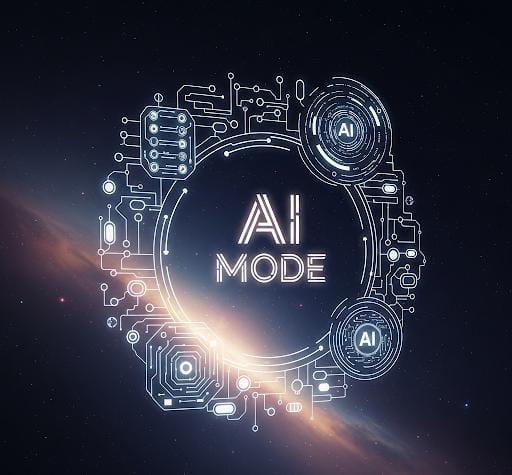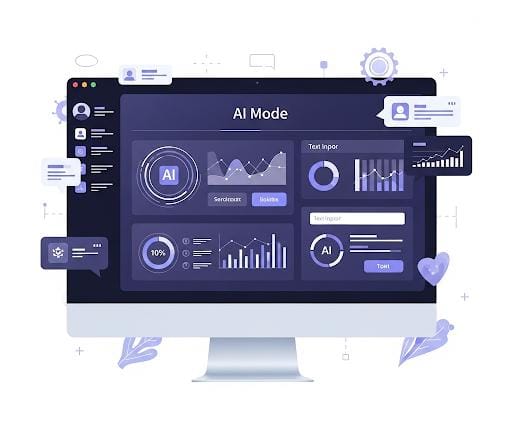Table of Contents
Introduction
Google just flipped the switch on something massive in India—AI Mode is live. If you’re a content creator, blogger, business owner, or marketer, this changes the entire game. Why? Because the way Google understands and ranks content is no longer keyword-first… It’s intent-first. Think of it as going from using a map to driving with GPS.
Let’s unpack everything you need to know about Google AI in India and how to optimize content for AI Search in 2025.
What is Google AI Mode?
Google AI Mode is a major update to the way search results are generated. Instead of showing only links based on keyword matches, Google now understands your query contextually using powerful AI—like Gemini and SGE (Search Generative Experience).
So if someone searches for “best camera for YouTube 2025,” instead of just listing pages, AI can generate a summary, product comparisons, and even pull insights from forums, YouTube videos, and niche blogs—all in one go.
Beyond simply understanding SGE, the real question for new bloggers is how to adapt your SEO strategy to thrive in this new landscape. To truly grasp the future of your content and ensure your blog’s visibility, dive deeper into our dedicated guide on the Google SGE SEO impact for beginners and learn the essential steps you need to take right now.

Google AI Mode Update India
The wait is over, India! Following successful beta tests in the US, Google AI officially began its rollout across the country in mid-2025. Here are the key highlights:
- Multilingual AI summaries (English, Hindi, Tamil, Bengali & more)
- Mobile-first focus for India’s large smartphone user base
- Experience the combined power of Google Lens, Maps, and YouTube, all working together effortlessly.
How Google AI Search Works
At its core, AI Search uses Google’s Gemini model to analyze content, break it down, summarize, and answer user queries more effectively.
Some changes include:
- Dynamic result generation (no two users see the same results)
- AI-generated snippets from multiple sources
- Prioritization of helpful content, not just popular content
Why AI Search Optimization Matters in 2025
Let’s be real: SEO has changed. With AI, your content can be skipped over if it doesn’t speak directly to what users need, not just what they type.
Traditional ranking signals are evolving:
- Keyword stuffing is dead.
- Intent and helpfulness rule.
- AI can “read between the lines” now.
If you’re not optimizing for AI, you’re leaving traffic—and revenue—on the table.
Key Differences Between Classic SEO and AI Search Optimization
| SEO Factor | Traditional SEO | AI Search Optimization |
|---|---|---|
| Keywords | Exact match | Semantic + contextual |
| Content | Informational | Conversational + Helpful |
| Snippets | Meta-based | AI-generated |
| Ranking | Static | Personalized |

Discover the secrets to ranking higher and driving more traffic! Unlock the power of AI with our hand-picked list of the Top 10 Powerful & Free AI Keyword Research Tools that will revolutionize your SEO strategy.
AI Search Optimization: A Content Guide
1. Focus on User Intent
Start by asking: What’s the user really looking for? Not just a product, but a solution. Write content that goes deep and solves the query completely.
2. Use Conversational Language
Alright, so here’s the thing: instead of sounding like a robot, let’s pretend we’re just chatting. You know, like, ‘Hey, let me break it down for you…’ or ‘Here’s the real deal with that.
3. Structure Content for AI Readability
Use plenty of headings, bullet points, lists, and FAQs. AI loves scanning clear structures.
4. Update Existing Content Regularly
Stale content gets skipped. Refresh articles with:
- Updated stats
- New tips
- Interactive elements like polls or videos
New Ranking Signals in Google AI Mode
E-E-A-T Enhanced
You need to show:
- Experience (real-world usage)
- Expertise (you know your stuff)
- Authoritativeness (others link to you)
- Trustworthiness (honest, well-cited content)
Semantic Relevance
AI now understands:
- Related topics
- Synonyms
- Contextual entities (brands, places, terms)
Content Freshness and Depth
Short posts? Not enough. Google AI prefers in-depth, updated content that stays helpful over time.
Is your website on Google’s ‘trust list’? EEAT is no longer just a factor; it’s become the cornerstone of your SEO strategy. To learn more about how you can improve your website’s EEAT and boost your rankings, click on our in-depth analysis: “How EEAT affects Google ranking.”
Technical SEO for AI Search
Schema Markup
Add structured data for:
- FAQs
- How-To’s
- Reviews
- Events
AI uses it to pull rich results.
Page Speed + Mobile UX
Fast-loading, mobile-optimized pages with great Core Web Vitals still win. AI doesn’t tolerate slow, clunky sites.

AI Search: The Best Content Formats to Use
Interactive Content
Tools like calculators, quizzes, and product finders are gold.
Video & Visuals
AI summarizes video/audio content, too! Use:
- YouTube embeds
- Infographics
- Voiceover guides
FAQs and How-To Guides
Answer the exact questions. “How to…” + “Best way to…” = featured snippets.
Tools to Optimize for AI Search in India
- Google Search Console (AI Insights tab)
- Rank Math SEO Pro: now includes AI Mode tools
- ChatGPT / Gemini: create content ideas and optimize answers
Real-World Case Study: Indian Bloggers Winning with AI Search
Example: A travel blogger in Himachal updated old posts using:
- FAQ sections
- Schema markup
- Conversational rewrites
Result? Traffic jumped by 85% in 30 days, and AI snippets featured them directly.
Future of Google AI Search in India
Expect more:
- Regional language support
- AI + Voice Search merge
- Google Lens + Search for visual discovery
Conclusion
The arrival of Google AI in India isn’t merely an update; it’s a seismic shift, a digital revolution that redefines the very essence of Search Engine Optimization. Gone are the days when SEO was primarily about dissecting complex algorithms and meticulously crafting content to satisfy their demands. Now, the paradigm has fundamentally shifted: SEO is about creating compelling, human-centric content, enhanced and amplified by the incredible capabilities of AI, rather than solely for algorithms.
This transformative change means that the true winners in the evolving search landscape will be those who embrace this human-first, AI-assisted approach. If you begin to optimize your content for AI Search today, focusing on depth, context, and genuine value for the user, you won’t just keep pace—you’ll surge ahead. This proactive adaptation will position you light years ahead, granting you a significant advantage over a staggering 90% of the web that is still clinging to outdated SEO methodologies. The future of search is here, and it demands content that resonates with human intelligence, guided by artificial intelligence.
Stay smart. Stay human. Optimize for intent, not just impressions.
FAQ’s
Q1. What is the difference between AI Mode and traditional Google Search?
ANS- Google’s AI (with those “AI Overviews” you keep hearing about) actually gives you the answer. It pulls information from wherever, summarizes it, and shoves it in your face directly. It’s supposed to save you the trouble of thinking, and yeah, it’s more chatty.
So, one gives you homework (links), the other just gives you the solution. Pick your poison.
Q2. How do I make my blog AI-search optimized?
ANS- Making your blog AI-search optimized comes down to being super clear and helpful. Focus on creating high-quality, unique content that genuinely answers questions people are asking. Use clear headings, lists, and short sentences to make your information easy to scan and digest. Directly answer common questions within your content, and ensure any images or videos are well-described with alt text. Ultimately, the goal is to make your content incredibly easy for anyone (human or AI) to understand and quickly pull answers from.
Q3. Is keyword research still important in AI Search?
ANS- Yes, absolutely! While AI Search understands natural language and user intent much better now, keyword research is still crucial. It helps you understand what people are actually searching for and the language they use, guiding you to create relevant content that AI can effectively find and present. It’s less about stuffing keywords and more about understanding the core topics and questions users have.
Q4. Can I rank in AI results without backlinks?
ANS- Yes, it’s possible for niche topics, but backlinks still play a significant role in showing Google’s AI (and traditional search) that your content is trustworthy and authoritative. Think of them as votes of confidence. While amazing, helpful content is key, high-quality backlinks help the AI understand your site’s credibility, making it more likely to be featured.
Q5. How do I know if my content appears in AI-powered results?
Figuring this out directly can be a bit tricky right now. Here’s the short version:
* Manual Checks: The easiest way is to simply search for your target keywords on Google yourself and see if an AI Overview appears and if your site is cited as a source within it.
* Google Search Console: Google has stated that clicks and impressions from AI Overviews are included in your regular Performance reports in Search Console, usually under the “Web” search type. However, it doesn’t currently break out AI-specific data, so you can’t filter to see only AI-driven traffic.
* Third-Party Tools: Some advanced SEO tools (like Ahrefs, Semrush, Keyword.com) are developing features that attempt to track when your content appears in AI Overviews for specific keywords.
So, while you can’t get a perfect, isolated report from Google yet, a combination of checking yourself and using some specialized tools is your best bet.

